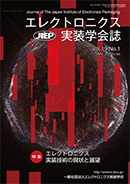Volume 19, Issue 3
Displaying 1-17 of 17 articles from this issue
- |<
- <
- 1
- >
- >|
Preface
-
2016Volume 19Issue 3 Pages P3
Published: 2016
Released on J-STAGE: August 01, 2016
Download PDF (756K)
Special Articles / Challenge for Monozukuri Innovation with Process Evaluation and Testing
-
2016Volume 19Issue 3 Pages 145
Published: 2016
Released on J-STAGE: August 01, 2016
Download PDF (886K) -
2016Volume 19Issue 3 Pages 146-150
Published: 2016
Released on J-STAGE: August 01, 2016
Download PDF (1428K) -
2016Volume 19Issue 3 Pages 151-157
Published: 2016
Released on J-STAGE: August 01, 2016
Download PDF (1950K) -
2016Volume 19Issue 3 Pages 158-160
Published: 2016
Released on J-STAGE: August 01, 2016
Download PDF (1183K) -
2016Volume 19Issue 3 Pages 161-165
Published: 2016
Released on J-STAGE: August 01, 2016
Download PDF (1833K) -
2016Volume 19Issue 3 Pages 166-169
Published: 2016
Released on J-STAGE: August 01, 2016
Download PDF (1619K)
Technical Paper
-
2016Volume 19Issue 3 Pages 170-176
Published: 2016
Released on J-STAGE: August 01, 2016
Download PDF (1817K) -
2016Volume 19Issue 3 Pages 177-183
Published: 2016
Released on J-STAGE: August 01, 2016
Download PDF (1616K)
Technical Report
-
2016Volume 19Issue 3 Pages 184-188
Published: 2016
Released on J-STAGE: August 01, 2016
Download PDF (1341K) -
2016Volume 19Issue 3 Pages 189-196
Published: 2016
Released on J-STAGE: August 01, 2016
Download PDF (2311K)
Report
-
2016Volume 19Issue 3 Pages 197
Published: 2016
Released on J-STAGE: August 01, 2016
Download PDF (1178K)
Report
-
2016Volume 19Issue 3 Pages 198-206
Published: 2016
Released on J-STAGE: August 01, 2016
Download PDF (1134K)
Announcement, Contents, etc.
-
2016Volume 19Issue 3 Pages 208-210
Published: 2016
Released on J-STAGE: August 01, 2016
Download PDF (1079K) -
2016Volume 19Issue 3 Pages A31-
Published: 2016
Released on J-STAGE: August 01, 2016
Download PDF (1432K) -
2016Volume 19Issue 3 Pages C31
Published: 2016
Released on J-STAGE: August 01, 2016
Download PDF (890K) -
2016Volume 19Issue 3 Pages C32
Published: 2016
Released on J-STAGE: August 01, 2016
Download PDF (821K)
- |<
- <
- 1
- >
- >|
